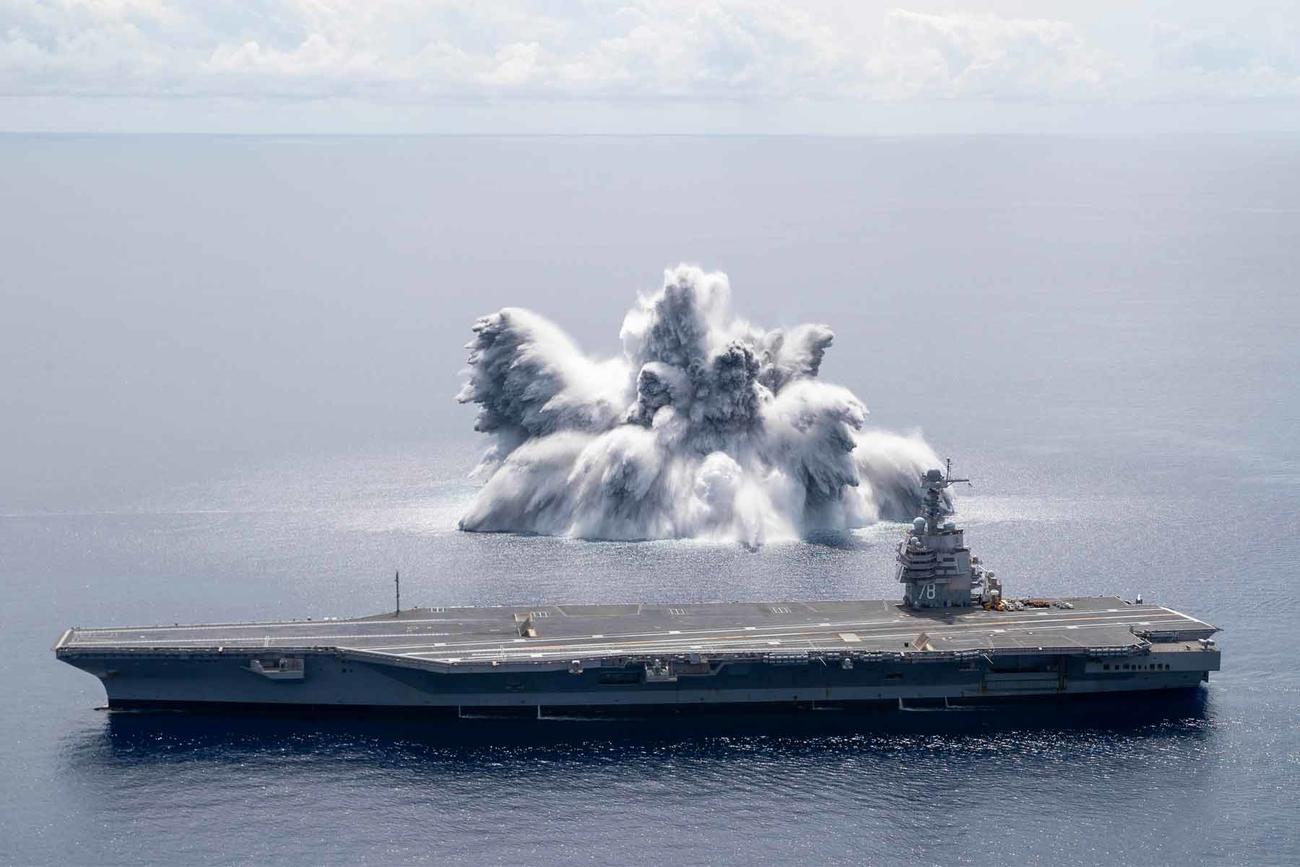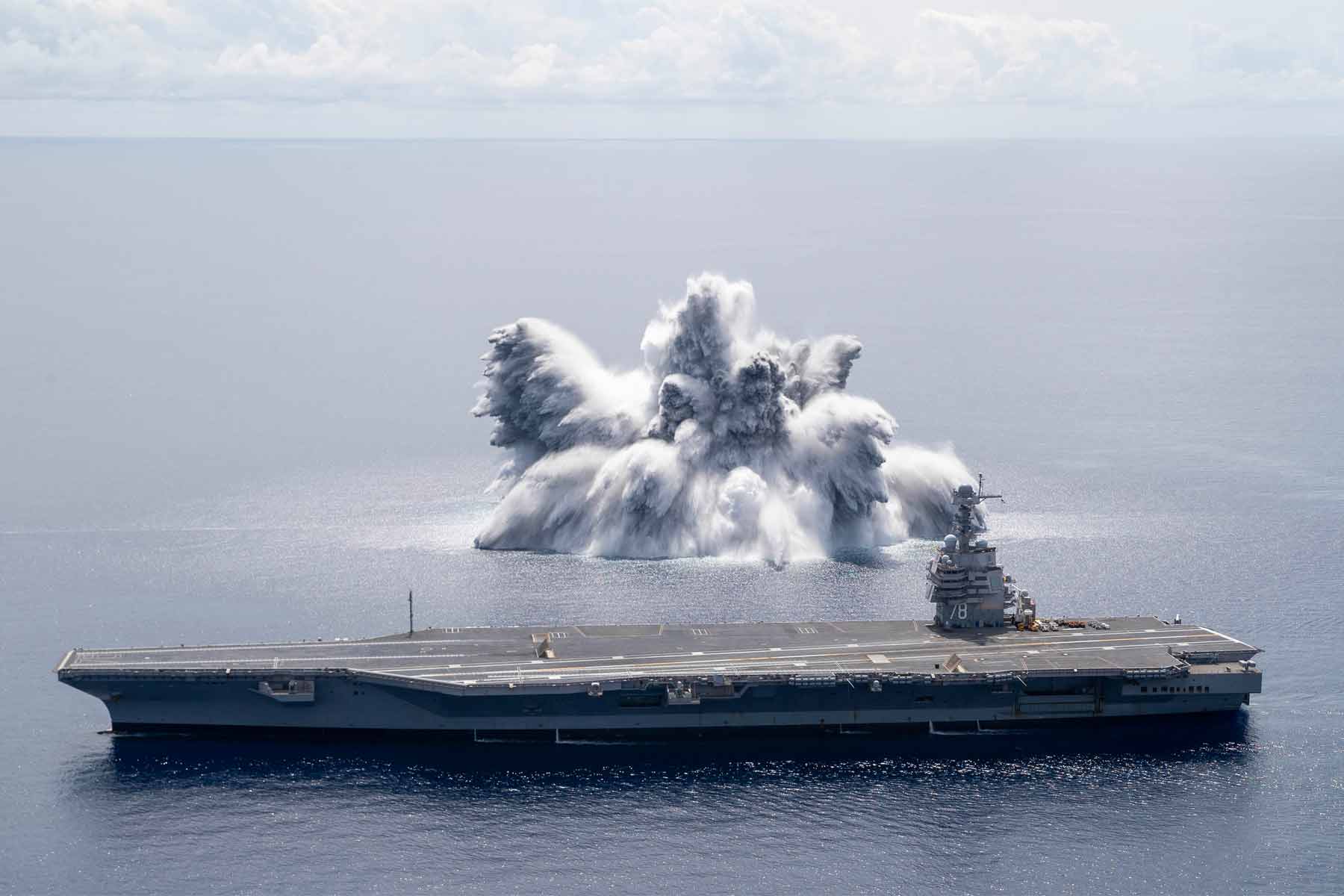

More than four years before the explosive went off beside the aircraft carrier Gerald R. Ford on June 18, a team of scientists began making plans for the ship’s shock trials. Their goal, however, was not battle readiness — they were trying to protect marine wildlife.
The process of planning the Ford’s shock trials began in 2016, according to Tom Douglas, the environmental impact director for the Navy’s shock trials.
“Planning for these are three to five years, if not a little bit longer,” he said.
“It takes quite a bit of effort.”
Shock trials have a long history in the Navy, going as far back as World War II when the service discovered that “near miss” explosions still had the potential to incapacitate a ship. As a result, the Navy conceived the test – which usually involves setting off explosives at various depths and distances from the ship – as a way to assess the impact of the shock and vibrations of a close blast on a ship’s equipment, a scientific report commissioned by the Navy explained.
However, setting off a large explosion underwater also has the potential to disorient and disrupt the normal patterns of life or kill nearby marine life. As a result, environmental considerations now factor into the Navy’s decision-making.
One of the key aspects of the planning process involves choosing a location and time to conduct the trials. Douglas’ team considered one of four locations available to conduct the test, ultimately settling on a site off the coast of Jacksonville, Florida.
“As far as surveys that have been conducted today, it has the lowest density of marine life, for any of the shock trial areas that we could utilize,” Bridget Watts, an expert working with the shock trial team, said. “We have gone back and looked at the past 50 years of wind and weather data to determine that June and July are the most optimum time of the year,” Douglas added.
The team also works the timing of the trial around the marine life that is in the area.
Douglas said that they have an “exclusion period” based on the migratory patterns of the North Atlantic right whale, one of the world’s most endangered large whales with less than 400 left alive today.
“We definitely want to do no harm,” Douglas said.
The Navy’s overall record on marine life preservation is a bit more mixed. For example, the service has been sued several times over the past two decades by environmental groups over its use of sonar in submarine exercises.
Last year, as part of its regular permit renewal, the Navy asked the National Marine Fisheries Service (NMFS) to increase the number of marine animals it harasses, harms, or kills in tests and training on the Pacific Coast.
Washington Gov. Jay Inslee said the allowed level of “incidental taking” — the regulatory term for anything from disrupted behavior to injury or death of a marine mammal — “unacceptable” in a letter to the regulator.
Five conservation directors from the state said in a joint letter to the NMFS that, “The approval of such a high level of incidental take without requiring any additional mitigation measures represents gross neglect.’’
The permission was granted on Nov. 9, 2020, though with a requirement to institute shutdowns and delays if marine mammals are sighted within certain distances and to limit sonar use in some areas.
On the day of the trial, the team deployed a group of observers, veterinarians and scientists aboard the carrier to help ensure that marine life is not harmed.
The Navy creates a 3.5 nautical mile area around the ship — a mitigation zone — in which no marine life can be located before the blast goes off.
“We have about 10 or 12 people on the target vessel whose entire job is monitoring the area around the mitigation zone as well as the area near [the] ship,” Douglas said.
Said Douglas: “The blast radius has potential harm to small animals out to one to two kilometers. We monitor three times that distance.”
If the team spots animals or cannot assess the entire mitigation zone effectively, it can halt the trial.
“There are several points … where the CO of the ship and the shock trail officer request a ‘go/no go’ from the chief scientist,” Douglas said.
Capt. Jeremy Shamblee, the executive officer of the Norfolk-based Ford, noted that the team delayed the trial twice.
After the blast, the team continues to monitor the area for days, using a boat and aircraft.
“Surveillance is partially geared on just making sure that we’ve covered those areas enough and give them enough time to be able to find someone that either we can help or that we have to deal with or that we recover them [so] we can learn something from it,” Dr. Michael Walsh, one of the veterinarians who assists in the trials, said.
All told, more than 30 people are involved in the environmental aspect of the shock trials on the Ford.
Shamblee said the ship is hoping to wrap up the other two explosions that are planned for the trial by August.
Once the Ford’s trials finish, Douglas said his work will go on.
“We’re always … looking for increased science,’’ Douglas said. “How can we better look at lessons learned from this? How can we better do the next shock trial?”
— Konstantin Toropin can be reached at [email protected]. Follow him on Twitter @ktoropin.
Related: After Australian Ship Hits 2 Whales, US Navy Says It Takes Steps to Protect Marine Life
© Copyright 2021 Military.com. All rights reserved. This material may not be published, broadcast, rewritten or redistributed.
